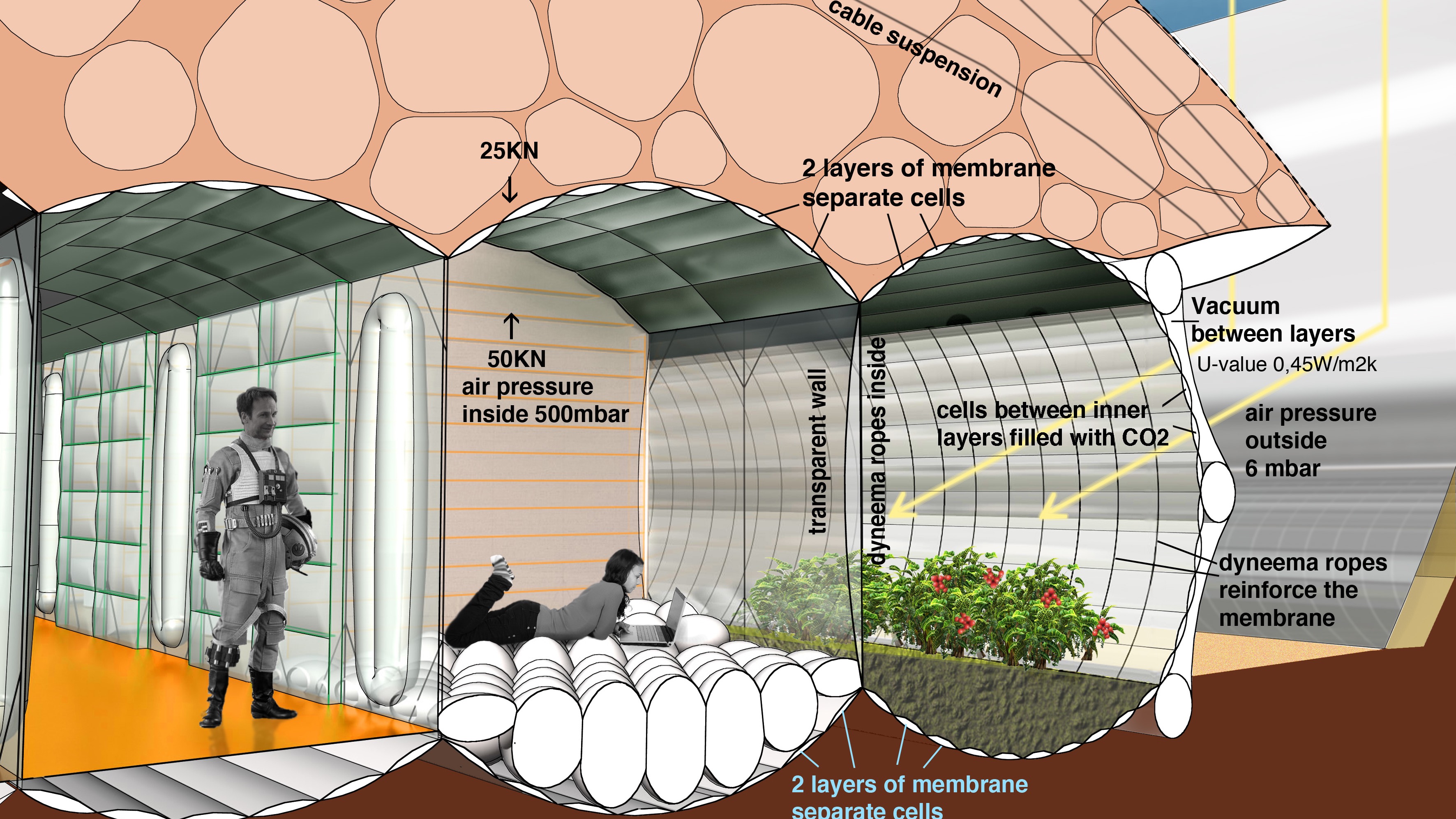The concept features a combination of:
1. Prefabricated ultra-light inflatable structures.
2. Covering the inflated structure with a 4 -5 meters thick layer of local loose regolith for efficient
protection from extreme temperature, meteorites and cosmic radiation.
3. The use of mirrors that move towards the sun and bring visible sunlight into the greenhouses.
As a first step, we identified the best suitable sites for the building of such a habitat both near the south pole and near the north pole of the Moon. Based on data from NASA’s Lunar Reconnaissance Orbiter (LRO) and on illumination models by Gläser et al. (2015, 2018), we identified the region C1 near the south pole and the area H0 near the north pole as best suited places for a habitat. These sites offer optimal illumination conditions and are in the close vicinity of PSR’s (Permanently Shadowed Regions), which have a high probability to contain near surface water ice. Moreover, suitable landing places in the near vicinity are available. The rim of the Shackleton crater itself, which often has been suggested as a site for the erection of a lunar polar habitat in previous studies, may not be a suitable place, because of the steepness and ruggedness of the terrain, which also includes possible mechanical instability of the ground. In order to evaluate the accessibility of solar irradiation over time, we calculated the solar illumination profile at the two sites both at the very surface and in a height of 10m and 20m, where the mirrors for the redirection of the horizontally infalling solar rays towards the lunar surface are mounted. We calculated that the longest period of uninterrupted total darkness is 11 days at the north polar H0 site, while at the south polar C1 site it is only 4 days. During the dark periods the electric power is served by batteries and/or fuel cells.
We also evaluated and compared our design with two other recent and carefully developed lunar habitat designs:
1. The Moon Village by SOM-Architects, which features a nearly “ready to use”, rigid and partly inflatable structure and
2. the Lunar Outpost by Foster & Partners, that consists of an inflatable structure covered by a 3D-printed shell.
In comparison, our PneumoPlanet design features by far the lowest payload per m2 of usable area, the most effective protection from cosmic particle radiation, and the lowest energy requirement for the construction process and in operation. Additionally, it is the only concept of all published until now, that provides a complete ecological cycle for self-sufficient production of food and oxygen.
A logical continuation of this study would be to build a prototype on earth, which can be used to investigate various details of the suggested components in more detail. Examples are: the performance of the electrostatic mirror foils, the life cycle inside the greenhouses, or the material properties of the inflatable foils and the transparent foil through which the solar illumination enters the greenhouse.
This patented concept is the first inflatable habitat for extraterrestrial planets and moons that perfectly shields against cosmic radiation and micrometeorites, but also makes sufficient natural sunlight usable inside to grow vegetable and fruits, to keep the habitat warm, and for the wellness of the inhabitants. An ultra light inflatable membrane structure is manufactured carefully and tested on Earth under ideal conditions. All the rest of the building material that shall protect from cold, radiation and meteorites shall come from loose regolith, which will be deposited on top of the inflatable structure. Since the atmospheric pressure on Mars is 6 mbar and almost zero on the Moon only, an inflatable structure inflated up to half Earth-atmospheric pressure can support an up to a 8 meters thick layer of regolith on Mars and twice as much on the Moon.The side walls are transparent and free of deposit. To protect the side walls from radiation and meteorites, an overhanging roof is installed which stops any direct sun radiation on the Maequator that comes vertically. Parallel along the transparent sidewalls we install mirror membranes that reflect the visible light into the greenhouse while the hard radiation penetrates the mirror membrane and is absorbed in the ground below. The angle of the mirror membrane can be adjusted so it can follow the seasonal declination of the sunlight. Thus inside the inflatable habitat we create a natural environment, where plants, microorganisms, animals and humans live in symbiosis. Find more information on www.marshabitat.space And. https://youtu.be/K4dLU3sa9bQ From this concept for a Mars Habitat I derived a similar application on Earth for an inflatable underground greenhouse in harsh climate regions. http://www.marshabitat.space/earthapplications.html I am building now a small prototype in Austria. The practical experience with that prototype will also help to improve the concept for a habitat/greenhouse on Mars and on the Moon

